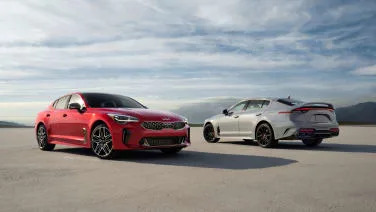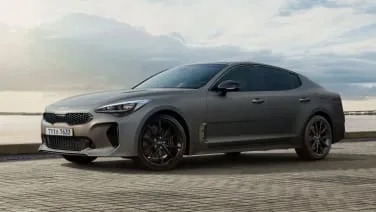GT2 4dr Rear-Wheel Drive Sedan
2022 Kia Stinger

Industry
Since its introduction, the Kia Stinger has been offered with two engines: a 255-horsepower 2.0-liter turbocharged four-cylinder and a 365-hp 3.3-liter twin-turbo V6. And although it still had the superb chassis, the four-cylinder was consistently outshined by its monster sibling with two extra cylinders and another turbo. It wasn't just because of the lower power output – the four-cylinder was also unremarkable with sluggish response to boot. That changes for 2022, as Kia has replaced the 2.0-liter engine with a 2.5-liter that makes much more power, and just as important, is livelier, more refined and better suited to a performance sedan like the Stinger. In fact, the new 2.5 makes a case for itself over the V6. While all the GT trims feature the V6, which is only slightly updated for 2022, the four-cylinder is exclusive to the GT-Line trim and vice versa. Output for the 2.5 is 300 hp and 311 pound-feet of torque, substantial increases of 45 horsepower and 51 pound-feet of torque over the old engine. And as you'd expect, it makes the Stinger GT-Line quicker than its predecessor, with the manufacturer's 0-60 mph time listed as 5.2 seconds versus 5.9 for the old car. Fuel economy improves, too, but not nearly to the same degree. When equipped with the standard rear-wheel drive, the Stinger GT-Line manages 22 mpg in the city, 32 on the highway and 25 in combined driving. The previous four-cylinder only got 29 mpg on the highway, though city and combined ratings were the same. Adding all-wheel-drive brings fuel economy down to 21 in the city, 29 on the highway and 24 in combined driving, the same as before. The V6 returns 20 mpg combined. Unlike its predecessor, the new 2.5-liter feels far livelier throughout the power band. When it's out of boost, it doesn't feel painfully slow thanks to its increased displacement, and the boost builds more rapidly. It comes on smoothly, too. The V6 tends to wallop you with its turbos. It's exhilarating, but isn't always welcome, especially if you're trying to be smooth and precise. So the smoothness and controllability of the four-cylinder is quite nice. Furthermore, the four-cylinder feels like it keeps making power in the high part of the rev band, whereas the old one seemed to lose power sooner. The eight-speed automatic is a good match for the engine as well, with smooth and prompt shifts that comes close to the famed ZF eight-speed in capability. Complementing the peppy four-pot is the eager, pointy nose. Having two fewer cylinders, just one twin-cam cylinder head and just one turbo means there's far less weight on the nose. As such, the Stinger GT-Line is more willing to sniff out apexes. The car feels better balanced, too, rather than feeling like the back end is much lighter. These are all great things when it has such a fantastically communicative chassis paired with super-quick and precise steering. It also makes it easier to catch the back end stepping out, which it will …
Full Review
Since its introduction, the Kia Stinger has been offered with two engines: a 255-horsepower 2.0-liter turbocharged four-cylinder and a 365-hp 3.3-liter twin-turbo V6. And although it still had the superb chassis, the four-cylinder was consistently outshined by its monster sibling with two extra cylinders and another turbo. It wasn't just because of the lower power output – the four-cylinder was also unremarkable with sluggish response to boot. That changes for 2022, as Kia has replaced the 2.0-liter engine with a 2.5-liter that makes much more power, and just as important, is livelier, more refined and better suited to a performance sedan like the Stinger. In fact, the new 2.5 makes a case for itself over the V6. While all the GT trims feature the V6, which is only slightly updated for 2022, the four-cylinder is exclusive to the GT-Line trim and vice versa. Output for the 2.5 is 300 hp and 311 pound-feet of torque, substantial increases of 45 horsepower and 51 pound-feet of torque over the old engine. And as you'd expect, it makes the Stinger GT-Line quicker than its predecessor, with the manufacturer's 0-60 mph time listed as 5.2 seconds versus 5.9 for the old car. Fuel economy improves, too, but not nearly to the same degree. When equipped with the standard rear-wheel drive, the Stinger GT-Line manages 22 mpg in the city, 32 on the highway and 25 in combined driving. The previous four-cylinder only got 29 mpg on the highway, though city and combined ratings were the same. Adding all-wheel-drive brings fuel economy down to 21 in the city, 29 on the highway and 24 in combined driving, the same as before. The V6 returns 20 mpg combined. Unlike its predecessor, the new 2.5-liter feels far livelier throughout the power band. When it's out of boost, it doesn't feel painfully slow thanks to its increased displacement, and the boost builds more rapidly. It comes on smoothly, too. The V6 tends to wallop you with its turbos. It's exhilarating, but isn't always welcome, especially if you're trying to be smooth and precise. So the smoothness and controllability of the four-cylinder is quite nice. Furthermore, the four-cylinder feels like it keeps making power in the high part of the rev band, whereas the old one seemed to lose power sooner. The eight-speed automatic is a good match for the engine as well, with smooth and prompt shifts that comes close to the famed ZF eight-speed in capability. Complementing the peppy four-pot is the eager, pointy nose. Having two fewer cylinders, just one twin-cam cylinder head and just one turbo means there's far less weight on the nose. As such, the Stinger GT-Line is more willing to sniff out apexes. The car feels better balanced, too, rather than feeling like the back end is much lighter. These are all great things when it has such a fantastically communicative chassis paired with super-quick and precise steering. It also makes it easier to catch the back end stepping out, which it will …
Hide Full Review
Hide Full Review
Retail Price
$51,490
MSRP / Window Sticker Price
| Engine | 3.3L V-6 |
| MPG | 18 City / 25 Hwy |
| Seating | 5 Passengers |
| Transmission | 8-spd w/OD |
| Power | 368 @ 6000 rpm |
| Drivetrain | rear-wheel |
Smart Buy Program is powered by 







